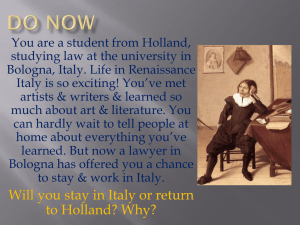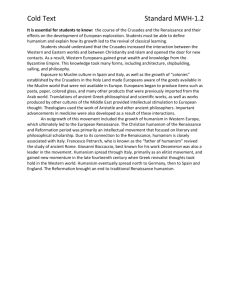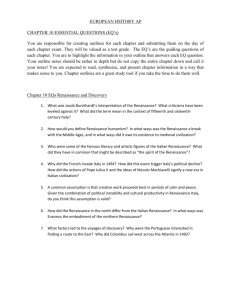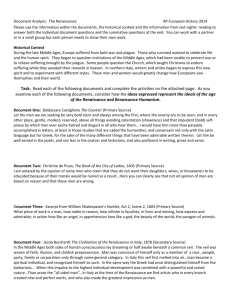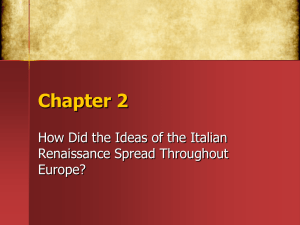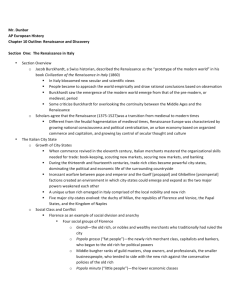Notes & Outline
advertisement
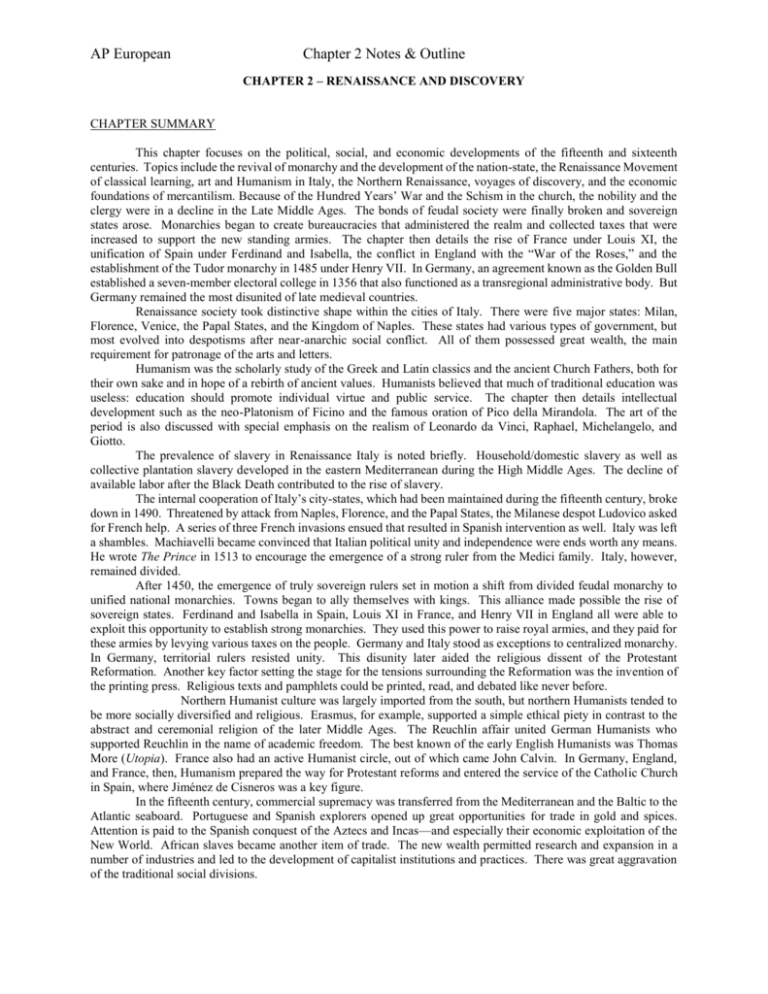
AP European Chapter 2 Notes & Outline CHAPTER 2 – RENAISSANCE AND DISCOVERY CHAPTER SUMMARY This chapter focuses on the political, social, and economic developments of the fifteenth and sixteenth centuries. Topics include the revival of monarchy and the development of the nation-state, the Renaissance Movement of classical learning, art and Humanism in Italy, the Northern Renaissance, voyages of discovery, and the economic foundations of mercantilism. Because of the Hundred Years’ War and the Schism in the church, the nobility and the clergy were in a decline in the Late Middle Ages. The bonds of feudal society were finally broken and sovereign states arose. Monarchies began to create bureaucracies that administered the realm and collected taxes that were increased to support the new standing armies. The chapter then details the rise of France under Louis XI, the unification of Spain under Ferdinand and Isabella, the conflict in England with the “War of the Roses,” and the establishment of the Tudor monarchy in 1485 under Henry VII. In Germany, an agreement known as the Golden Bull established a seven-member electoral college in 1356 that also functioned as a transregional administrative body. But Germany remained the most disunited of late medieval countries. Renaissance society took distinctive shape within the cities of Italy. There were five major states: Milan, Florence, Venice, the Papal States, and the Kingdom of Naples. These states had various types of government, but most evolved into despotisms after near-anarchic social conflict. All of them possessed great wealth, the main requirement for patronage of the arts and letters. Humanism was the scholarly study of the Greek and Latin classics and the ancient Church Fathers, both for their own sake and in hope of a rebirth of ancient values. Humanists believed that much of traditional education was useless: education should promote individual virtue and public service. The chapter then details intellectual development such as the neo-Platonism of Ficino and the famous oration of Pico della Mirandola. The art of the period is also discussed with special emphasis on the realism of Leonardo da Vinci, Raphael, Michelangelo, and Giotto. The prevalence of slavery in Renaissance Italy is noted briefly. Household/domestic slavery as well as collective plantation slavery developed in the eastern Mediterranean during the High Middle Ages. The decline of available labor after the Black Death contributed to the rise of slavery. The internal cooperation of Italy’s city-states, which had been maintained during the fifteenth century, broke down in 1490. Threatened by attack from Naples, Florence, and the Papal States, the Milanese despot Ludovico asked for French help. A series of three French invasions ensued that resulted in Spanish intervention as well. Italy was left a shambles. Machiavelli became convinced that Italian political unity and independence were ends worth any means. He wrote The Prince in 1513 to encourage the emergence of a strong ruler from the Medici family. Italy, however, remained divided. After 1450, the emergence of truly sovereign rulers set in motion a shift from divided feudal monarchy to unified national monarchies. Towns began to ally themselves with kings. This alliance made possible the rise of sovereign states. Ferdinand and Isabella in Spain, Louis XI in France, and Henry VII in England all were able to exploit this opportunity to establish strong monarchies. They used this power to raise royal armies, and they paid for these armies by levying various taxes on the people. Germany and Italy stood as exceptions to centralized monarchy. In Germany, territorial rulers resisted unity. This disunity later aided the religious dissent of the Protestant Reformation. Another key factor setting the stage for the tensions surrounding the Reformation was the invention of the printing press. Religious texts and pamphlets could be printed, read, and debated like never before. Northern Humanist culture was largely imported from the south, but northern Humanists tended to be more socially diversified and religious. Erasmus, for example, supported a simple ethical piety in contrast to the abstract and ceremonial religion of the later Middle Ages. The Reuchlin affair united German Humanists who supported Reuchlin in the name of academic freedom. The best known of the early English Humanists was Thomas More (Utopia). France also had an active Humanist circle, out of which came John Calvin. In Germany, England, and France, then, Humanism prepared the way for Protestant reforms and entered the service of the Catholic Church in Spain, where Jiménez de Cisneros was a key figure. In the fifteenth century, commercial supremacy was transferred from the Mediterranean and the Baltic to the Atlantic seaboard. Portuguese and Spanish explorers opened up great opportunities for trade in gold and spices. Attention is paid to the Spanish conquest of the Aztecs and Incas—and especially their economic exploitation of the New World. African slaves became another item of trade. The new wealth permitted research and expansion in a number of industries and led to the development of capitalist institutions and practices. There was great aggravation of the traditional social divisions. AP European Chapter 2 Notes & Outline OUTLINE I. The Renaissance in Italy A. The Italian City-State B. Humanism Read the Document “Petrarch, Letter to Cicero (14th c.)” on MyHistoryLab.com Read the Document “Divine Comedy (1321)” on MyHistoryLab.com View the Closer Look “Primavera” on MyHistoryLab.com C. Renaissance Art Watch the Video “The Italian Renaissance” on MyHistoryLab.com Read the Document “Giorgio Vasari on the Life of Michelangelo, 1550” on MyHistoryLab.com D. Slavery in the Renaissance II. Italy’s Political Decline: The French Invasions (1494–1527) A. Charles VIII’s March through Italy B. Pope Alexander VI and the Borgia Family C. Pope Julius II - Read the Document ”Desiderius Erasmus, ‘Pope Julius Excluded from Heaven,’ 1513– 1514” on MyHistoryLab.com D. Niccolò Machiavelli - Read the Document “The Prince (1519) Machiavelli” on MyHistoryLab.com III. Revival of Monarchy in Northern Europe View the Map “Geographical Tour: Europe in 1500” on MyHistoryLab.com Read the Document “Jean Bodin, Six Books of the Commonwealth” on MyHistoryLab.com A. France B. Spain C. England D. The Holy Roman Empire IV. The Northern Renaissance View the Closer Look “Rogier Van Der Weyden, Deposition” on MyHistoryLab.com A. The Printing Press - View the Image “Gutenberg Bible” on MyHistoryLab.com B. Erasmus C. Humanism and Reform Read the Document “Utopia (1516)” on MyHistoryLab.com V. Voyages of Discovery and the New Empires in the West and East A. The Portuguese Chart the Course B. The Spanish Voyages of Columbus C. The Spanish Empire in the New World D. The Church in Spanish America E. The Economy of Exploitation Watch the Video “Video Lectures: The Columbian Exchange” on MyHistoryLab.com F. The Impact on Europe
